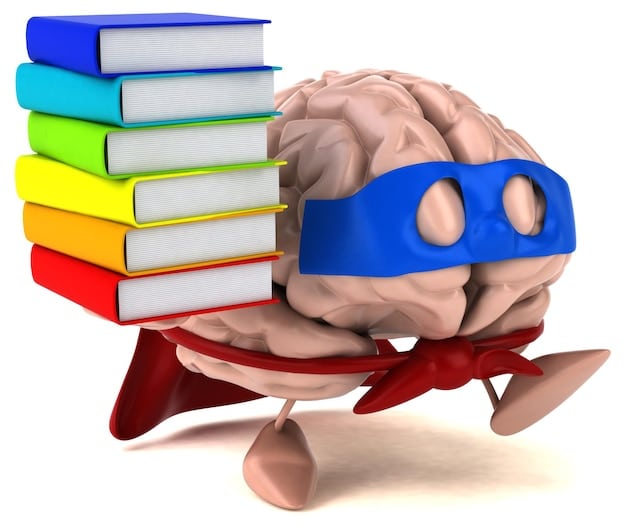US Education’s Future: AI & Personalized Learning

The future of US education is poised for a transformative shift, with artificial intelligence serving as a pivotal enabler for personalized learning experiences that cater to individual student needs and foster deeper engagement.
The landscape of education is continuously evolving, driven by technological advancements and a deeper understanding of how individuals learn. Within the United States, a significant paradigm shift is on the horizon: the integration of artificial intelligence to catalyze an unprecedented era of personalized learning with AI. This evolution promises to reshape classrooms, empowering students and educators alike.
The dawn of AI in US education
The integration of artificial intelligence into the US education system is no longer a distant theoretical concept; it is rapidly becoming a tangible reality. This integration is fundamentally shifting how educators teach and how students learn, moving away from a one-size-fits-all model towards a more tailored, dynamic approach. AI’s capacity to process vast amounts of data and identify patterns allows for profound insights into individual learning styles, strengths, and areas requiring additional support.
Historically, educational systems have struggled to effectively address the diverse needs within a single classroom. Teachers, despite their dedication, are often overwhelmed by large class sizes and standardized curricula, making true individualization a monumental challenge. AI offers a scalable solution, providing tools that can analyze student performance, adapt content, and recommend specific resources, effectively acting as an intelligent assistant for both students and instructors.
Understanding the shift to personalized learning
Personalized learning, at its core, is about tailoring the educational experience to meet the unique needs and preferences of each student. This goes beyond simply differentiating instruction; it involves a holistic approach that considers a student’s pace, style, interests, and prior knowledge. AI significantly enhances this capability by:
- Adaptive learning platforms: These platforms adjust the difficulty and content of material in real-time based on a student’s performance.
- Intelligent tutoring systems: Providing instant feedback and customized explanations, mimicking the role of a personal tutor.
- Automated assessment tools: Grading assignments and identifying common misconceptions, freeing up teacher time.
The ultimate goal is to create an educational environment where every student feels supported, challenged, and engaged in their learning journey. This shift is not just about adopting new technologies; it’s about reimagining the very structure and delivery of education to foster deeper understanding and lifelong learning skills.
As AI continues to evolve, its applications in education will become even more sophisticated, offering unparalleled opportunities for customizing the learning experience. This new era promises to make education more equitable and effective, ensuring that every student has the optimal conditions to thrive. The early implementations are showing promising results, highlighting the potential for widespread positive impacts across the nation’s schools.
Transforming the classroom experience
AI’s influence extends deeply into the daily operations of the classroom, moving beyond theoretical applications to practical, real-world implementations. The traditional classroom setup, often characterized by a teacher delivering information to a multitude of students, is undergoing a profound transformation. AI tools are enabling educators to create dynamic, interactive, and highly responsive learning environments that were previously unimaginable. This transformation is not about replacing teachers, but empowering them with sophisticated tools to enhance their effectiveness and focus on higher-order teaching tasks.
One of the most significant impacts of AI is its ability to free up valuable teacher time. Repetitive tasks such as grading, administrative duties, and even creating differentiated assignments can now be automated or significantly streamlined by AI. This allows educators to dedicate more energy to mentorship, fostering critical thinking, and addressing the social-emotional needs of their students. The role of the teacher evolves from a disseminator of information to a facilitator of learning, a mentor, and a guide.
AI-powered adaptive learning platforms
Adaptive learning platforms are at the forefront of this classroom transformation. These systems continuously assess a student’s progress and understanding, then dynamically adjust the curriculum, content delivery, and even the type of questions presented. For instance, if a student masters a concept quickly, the platform can automatically advance them to more complex material. Conversely, if a student struggles, the system can provide additional support, alternative explanations, or practice exercises until mastery is achieved.
- Personalized pacing: Students can learn at their own speed, reducing anxiety and frustration.
- Targeted interventions: AI identifies specific areas of weakness, allowing for immediate and direct support.
- Engagement through relevance: Content can be personalized to students’ interests, increasing motivation.
- Data-driven insights: Teachers gain valuable data on student performance, informing their instructional decisions.
This level of individualization ensures that no student is left behind, nor is any student held back by the pace of the general class. It cultivates a sense of agency in learners, as they become more active participants in their educational journey, taking ownership of their progress.
Furthermore, AI tools can facilitate collaborative learning experiences. While personalized learning often highlights individual paths, AI can also intelligently group students based on complementary strengths or shared learning gaps, creating effective peer-to-peer learning opportunities. This blend of individual and collaborative approaches enriches the overall classroom experience, making it more engaging and effective for a diverse student population.
Challenges and ethical considerations
While the prospect of AI transforming personalized learning in US education offers immense potential, it is crucial to acknowledge and address the significant challenges and ethical considerations that accompany this technological shift. Without careful planning and robust safeguards, the very benefits AI promises could be undermined, potentially exacerbating existing inequalities or introducing new concerns.
One of the primary challenges lies in ensuring equitable access to these advanced technologies. Schools in underprivileged areas often lack the necessary infrastructure, funding, and trained personnel to effectively implement AI-powered learning solutions. This digital divide could widen the achievement gap, leaving some students further behind. Bridging this gap requires substantial investment in technology infrastructure, teacher training, and creating policies that promote equitable adoption across all socioeconomic strata.
Data privacy and security concerns
The collection and analysis of vast amounts of student data is fundamental to personalized learning with AI. This raises profound questions about data privacy and security. Student data, including academic performance, learning behaviors, and even emotional responses, is highly sensitive. Protecting this information from breaches, misuse, or unauthorized access is paramount. Robust cybersecurity measures and clear, enforceable data governance policies are essential to build trust among parents, students, and educators.
- Consent and transparency: Clear communication with parents and students about what data is collected, how it is used, and who has access to it.
- Anonymization and aggregation: Employing techniques to de-identify data where possible, especially for research or policy development.
- Regulatory frameworks: Developing and enforcing strong regulations specific to educational data to prevent commercial exploitation or discriminatory practices.
Beyond privacy, there are ethical dilemmas concerning algorithmic bias. AI algorithms are trained on existing data, which can sometimes reflect and perpetuate societal biases. If educational AI systems are trained on biased data, they could inadvertently lead to discriminatory outcomes, for example, by misidentifying learning difficulties or unfairly channeling students into certain academic tracks based on demographic rather than individual capability. Ensuring fairness and transparency in algorithmic design is a continuous, complex challenge that requires diverse input from educators, ethicists, and technologists.
Another concern is the potential over-reliance on AI, which could diminish human interaction and critical thinking skills. While AI can provide personalized content, the nuances of human mentorship, empathy, and classroom dynamics remain irreplaceable. Striking the right balance between AI-driven learning and human-led instruction is vital to fostering well-rounded individuals. Moreover, developing students’ ability to critically evaluate AI-generated information and understand its limitations will become an increasingly important skill in an AI-permeated world.
Teacher’s evolving role in an AI-powered system
As artificial intelligence becomes increasingly integrated into the US education system, the role of the teacher is undergoing a profound and necessary evolution. Far from being rendered obsolete, educators are poised to become even more crucial, albeit with a refined set of responsibilities and skills. The shift is from being the primary disseminator of information to becoming a highly skilled facilitator, mentor, and guide in an increasingly complex and personalized learning environment.
AI’s ability to handle routine tasks—like grading, tracking progress, and delivering basic instruction—frees up teachers to focus on higher-order educational objectives. This means more time for individualized attention, addressing emotional and social needs, fostering creativity, and encouraging critical thinking that AI tools, for all their sophistication, cannot fully replicate. The human element of teaching, characterized by empathy, intuition, and the ability to inspire, becomes even more prominent.
From instructor to learning facilitator
In an AI-augmented classroom, the teacher transforms into a learning facilitator. Their primary role shifts to:
- Curating and customizing content: Leveraging AI tools to select and adapt learning materials that best suit individual student needs and interests.
- Diagnostic assessment and intervention: Using AI-generated data to identify deeper learning challenges and implement targeted, human-led interventions.
- Fostering critical thinking and creativity: Designing projects and discussions that require higher-level cognitive skills, where AI can assist but not replace human ingenuity.
- Building relationships and socio-emotional support: Focusing on the holistic development of students, understanding their motivations, and providing emotional encouragement.
This new paradigm requires educators to develop strong technological literacy, not just in operating AI tools, but in understanding their capabilities and limitations. Professional development programs will be essential to equip teachers with the skills to interpret AI data, integrate personalized learning pathways, and navigate the ethical considerations of AI in education. Teachers will need to become adept at collaborating with AI, using it as a powerful assistant rather than a replacement.
Furthermore, teachers will play a pivotal role in teaching students how to effectively interact with and learn from AI. This includes developing digital literacy, understanding algorithmic processes, and cultivating a discerning approach to information gathered through AI systems. The teacher’s unique position allows them to model and instill these crucial 21st-century skills, preparing students not just for academic success, but for life in a world increasingly shaped by advanced technology. The future classroom will be a partnership between human intelligence and artificial intelligence, orchestrated by the skilled hands of adaptive educators.
Impact on student engagement and outcomes
The core promise of personalized learning with AI in US education lies in its potential to dramatically enhance student engagement and, consequently, improve learning outcomes. Traditional education models, with their emphasis on uniformity, often struggle to keep all students adequately motivated and challenged. AI offers a powerful antidote to this, creating learning experiences that are inherently more relevant, responsive, and rewarding for each individual.
When learning is personalized, students are more likely to stay engaged because the content directly addresses their needs, interests, and learning styles. AI can recommend resources that resonate with a student’s prior knowledge or curiosities, making the learning process less like a chore and more like an exploration. This intrinsic motivation is a far more powerful driver of sustained learning than external pressures.
Cultivating deeper understanding and mastery
Beyond engagement, AI contributes significantly to improved learning outcomes by facilitating deeper understanding and mastery of subjects. Adaptive systems ensure that students don’t move on before grasping foundational concepts, preventing knowledge gaps from accumulating over time. They provide immediate feedback, allowing students to correct misconceptions in real-time rather than waiting for formal assessments. This iterative process of learning, practice, and immediate correction is highly effective for solidifying understanding.
- Reduced frustration: Students receive support precisely when and where they need it, reducing feelings of being overwhelmed.
- Maximized potential: High-achieving students are challenged appropriately, preventing boredom and fostering continuous growth.
- Enhanced critical thinking: AI can free up time for project-based learning and problem-solving, which develop higher-order thinking skills.
- Data-informed decision-making: Educators can precisely identify areas where individual students or groups need additional support, making interventions more effective.
The ability of AI to analyze vast amounts of student performance data also provides unparalleled insights into learning patterns and efficacy of various teaching methods. This data-driven approach allows educators to refine their strategies and tailor their instruction more effectively, leading to continuous improvements in pedagogical practices schools-wide. Ultimately, this leads to a more efficient and effective educational system that serves the diverse needs of its student population.
Moreover, personalized learning cultivated by AI fosters a sense of agency and ownership over education in students. When they see their progress directly reflected in the personalized pathways and receive immediate, relevant feedback, they become more active participants in their own learning journey. This intrinsic motivation, coupled with tailored support, cultivates not only academic success but also important life skills such as self-regulation, problem-solving, and a lifelong love of learning.
The road ahead: Implementation and future outlook
The journey towards a fully AI-integrated, personalized learning environment in US education is undeniably complex, but the trajectory is clear and the potential benefits are too significant to ignore. The road ahead involves not just technological adoption, but a comprehensive overhaul of infrastructure, pedagogical approaches, and policy frameworks. Successful implementation will require collaboration among policymakers, educators, technology developers, and communities.
A phased approach to implementation is likely the most pragmatic. This includes pilot programs in diverse school settings to assess efficacy, identify challenges specific to different demographics, and gather feedback from all stakeholders. Scaling successful initiatives requires substantial federal and state funding, as well as private sector partnerships, to ensure that the transformative power of AI in education reaches every student, regardless of their geographical or socioeconomic background.
Crucial steps for widespread adoption
For widespread adoption of personalized learning with AI, several critical steps must be taken:
- Robust infrastructure development: Ensuring all schools have reliable high-speed internet access and sufficient computing devices.
- Comprehensive teacher training: Developing professional development programs that equip educators with the skills to effectively use and integrate AI tools.
- Curriculum adaptation: Revising curricula to leverage AI’s capabilities, allowing for more dynamic and adaptive content delivery.
- Ethical guidelines and policies: Establishing clear regulations around data privacy, algorithmic bias, and equitable access.
- Research and development: Continual investment in R&D to refine AI educational tools and explore new applications.
The future outlook for personalized learning with AI in US education is overwhelmingly positive, albeit with the caveat that these challenges are responsibly addressed. We can anticipate a future where learning is truly customized to each student’s potential, where educators are empowered to focus on the human aspects of teaching, and where the educational system is more resilient and adaptable to a rapidly changing world. The emphasis will shift from rote memorization to higher-order skills, critical thinking, creativity, and collaborative problem-solving – attributes essential for the 21st-century workforce.
As this transformation unfolds, the very definition of a “classroom” may evolve, becoming more flexible and extending beyond traditional walls through virtual AI-powered learning environments. This will not only impact K-12 education but also higher education and lifelong learning, creating a continuous, adaptable, and personalized educational journey for all Americans. The commitment now must be to ensure this future is equitable, effective, and ethically sound.
| Key Aspect | Brief Description |
|---|---|
| 🤖 AI Integration | AI is transforming US education from standardized to tailored learning. |
| 🎓 Personalized Learning | Tailors education to individual student needs, pace, and interests for deeper engagement. |
| 🧑🏫 Evolving Teacher Role | Teachers become facilitators and mentors, focusing on critical thinking and socio-emotional support. |
| 📊 Challenges & Ethics | Addresses concerns like data privacy, algorithmic bias, and equitable access across schools. |
Frequently Asked Questions About AI in US Education
▼
Personalized learning with AI involves using artificial intelligence technologies to customize educational experiences for individual students. This includes adaptive learning platforms, intelligent tutoring systems, and AI-driven assessment tools that adjust content and pace based on a student’s unique needs, strengths, and learning style. The goal is to provide tailored support and challenge, optimizing each student’s potential.
▼
AI benefits students by providing individualized learning paths, immediate feedback, and targeted support. It helps reduce frustration by allowing students to learn at their own pace, challenges high-achievers, and pinpoints areas needing improvement. This leads to higher engagement, deeper understanding of concepts, and ultimately, improved academic outcomes as education becomes more relevant and responsive to their specific needs.

▼
The role of teachers is evolving from primary instructors to facilitators, mentors, and guides. AI handles routine tasks, freeing teachers to focus on fostering critical thinking, creativity, and socio-emotional development. Educators use AI-generated data to provide targeted interventions, curate customized content, and build stronger relationships with students. This enhances their capacity to personalize learning effectively.
▼
Key challenges include ensuring equitable access to technology across all schools, addressing data privacy and security concerns associated with sensitive student information, and mitigating algorithmic bias that could lead to discriminatory outcomes. Additionally, comprehensive teacher training and adapting existing curricula are necessary to fully integrate AI effectively into the educational landscape nationwide.

▼
In the long term, AI is expected to create a more adaptive, equitable, and efficient educational system in the US. It will enable truly continuous and personalized learning journeys from K-12 through higher education and lifelong learning. The focus will shift towards developing higher-order thinking skills, making education more resilient and responsive to global changes, preparing students more effectively for future careers.
Conclusion
The integration of artificial intelligence into the US education system marks a pivotal moment, promising a future where learning is truly personalized, dynamic, and profoundly effective. While the journey involves navigating significant challenges related to equity, privacy, and teacher integration, the transformative potential of AI to enhance student engagement, deepen understanding, and customize learning pathways is undeniable. By embracing thoughtful implementation and ongoing adaptation, the US educational landscape stands on the precipice of an exciting new era, one that redefines learning for generations to come, fostering a society of lifelong learners prepared for the complexities of the 21st century.





